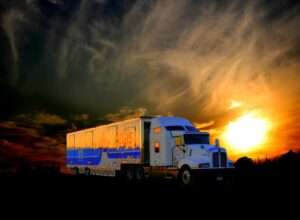The Fascinating World of the American Trucking Industry
Introduction to the American Trucking Industry
The American trucking industry is a crucial component of the country’s economy. From delivering goods to manufacturing plants to transporting finished products to stores and warehouses, trucks are the backbone of the logistics industry. The industry generates billions of dollars in revenue every year and employs millions of people across the country. In this blog post, we will take a closer look at the American trucking industry, its history, its current state, and its future prospects.

A Brief History of American Trucking Industry
In the early 1900s, the first trucks were used to transport goods between cities and towns. These early trucks were crude, unreliable, and had limited cargo capacity. However, they were still an improvement over the previous modes of transportation, which involved horse-drawn wagons and trains.
By the 1920s, the American trucking industry had begun to grow rapidly, with more and more companies entering the market. The introduction of paved highways and roads also made it easier to transport goods over longer distances. The growth of the American trucking industry led to the formation of the American Trucking Association (ATA) in 1933, which aimed to represent the interests of trucking companies and promote the industry as a whole.
During World War II, the trucking industry played a critical role in the war effort, transporting troops, supplies, and equipment across the country. After the war, the industry continued to grow, with the introduction of larger, more powerful trucks and the construction of the Interstate Highway System in the 1950s and 1960s.
In the 1970s and 1980s, the industry faced significant challenges, including rising fuel costs, increased competition, and deregulation. However, technological advances and the adoption of new safety regulations helped to improve efficiency and reduce accidents. Today, the American trucking industry is a vital component of the American economy, transporting billions of tons of goods each year and providing employment to millions of people.
The State of the American Trucking Industry Today
The American trucking industry is currently facing several challenges, including a shortage of drivers, rising fuel costs, and increased competition from other modes of transportation. Despite these challenges, the industry continues to grow, with the demand for goods transportation increasing due to the growth of e-commerce and online retail. One of the biggest challenges facing the trucking industry is the shortage of drivers. According to the ATA, there is currently a shortage of over 60,000 drivers, and this number is expected to increase in the coming years. This shortage can be attributed to several factors, including an aging workforce, a lack of interest among younger generations in truck driving as a career, and the high cost of obtaining a commercial driver’s license (CDL).
Another significant challenge facing the trucking industry is rising fuel costs. Fuel is one of the largest expenses for trucking companies, and fluctuations in fuel prices can have a significant impact on their bottom line. Additionally, the trucking industry is facing increased competition from other modes of transportation, such as rail and air freight. While trucking is still the most popular mode of transportation for goods in the USA, other options are becoming more viable, especially for long-distance and international shipments.
Despite these challenges, the trucking industry continues to grow and adapt. The growth of e-commerce and online retail has created new opportunities for the industry, as companies need to transport goods quickly and efficiently to meet customer demands. The use of technology, such as GPS tracking and electronic logging devices (ELDs), has also helped to improve efficiency and safety in the industry.
The Role of the American Trucking Industry in the Economy
The American trucking industry plays a critical role in the economy, with its impact felt across multiple sectors. Here are some of the ways the industry contributes to the country’s economic growth:
-
Job Creation
The American trucking industry is one of the largest employers in the country, providing jobs for millions of people. From drivers to mechanics, dispatchers, and warehouse workers, the industry offers a wide range of employment opportunities. According to the ATA, the trucking industry employs over 7 million people, making it one of the largest employers in the USA. The industry offers a diverse range of job opportunities, with different levels of education and experience required for various roles. Truck drivers are the backbone of the industry, and there is a constant demand for skilled and experienced drivers. In addition to driving the trucks, drivers are also responsible for inspecting their vehicles, loading and unloading cargo, and maintaining accurate records. They must also adhere to safety regulations and ensure that their cargo is delivered on time and in good condition.
Mechanics and technicians are also essential to the industry, as they are responsible for maintaining and repairing the trucks and equipment. They must have a good understanding of the mechanics of the trucks and be able to diagnose and fix any issues that arise. Dispatchers are another crucial part of the industry, as they are responsible for coordinating shipments, communicating with drivers, and ensuring that deliveries are made on time. Rewton Logistics is also offering dispatch services. If you are the truck owner then you must contact them for high-paying loads for your trucks. Warehouse workers are also an essential part of the industry, as they are responsible for loading and unloading cargo and ensuring that it is stored correctly. They must be able to work efficiently and effectively, as delays in the warehouse can lead to delays in the delivery of goods.
Overall, the American trucking industry provides a significant number of jobs and offers opportunities for people with a range of skills and experience levels. As the industry continues to grow and evolve, there will likely be an increasing demand for workers with specialized skills and knowledge.

-
Goods Movement
The movement of goods is a critical component of the American economy, and the trucking industry is responsible for transporting a significant portion of these goods. The industry plays a vital role in connecting manufacturers and suppliers with retailers and consumers, ensuring that goods are transported quickly and efficiently. Trucking companies are responsible for transporting a wide range of goods, including raw materials, components, and finished products. This includes everything from steel and wood to electronics and clothing. The industry is also responsible for transporting perishable goods like food and pharmaceuticals, which require specialized handling and transportation.
In addition to transporting goods across the country, the American trucking industry also plays a crucial role in delivering essential items to communities during times of crisis. For example, during the COVID-19 pandemic, truck drivers were responsible for transporting medical supplies and equipment, food, and other essential items to communities across the country. Overall, the trucking industry plays a crucial role in the movement of goods throughout the country. Without the industry, it would be difficult to transport goods efficiently, leading to delays in the delivery of products and potentially harming the economy. The industry’s importance is likely to continue to grow as e-commerce and online retailing continue to expand, leading to increased demand for goods transportation.
-
Economic Impact
The American trucking industry generates billions of dollars in revenue every year, contributing significantly to the country’s GDP. According to the American Trucking Association, the industry’s total revenue in 2020 was $791.7 billion. This figure is expected to grow in the coming years, as the demand for goods transportation continues to increase. The economic impact of the trucking industry extends beyond its revenue generation. The industry also supports a wide range of other businesses, from truck manufacturers and parts suppliers to truck stops and rest areas. It also plays a critical role in the country’s supply chain, ensuring that goods are transported from manufacturers to retailers and ultimately to consumers. Without the trucking industry, many businesses would struggle to get their products to market, leading to a slowdown in the economy. Therefore, the trucking industry is a vital component of the country’s economic growth and development.
Challenges Facing the American Trucking Industry
Despite its crucial role in the economy, the American trucking industry faces several challenges that threaten its sustainability. Here are some of the most pressing issues:
-
Driver Shortages
The shortage of qualified drivers is one of the most significant challenges facing the trucking industry in the USA. According to industry experts, this shortage can be attributed to several factors, including an aging workforce, low wages, and high turnover rates. One of the primary factors contributing to the shortage of drivers is the aging workforce. As more and more drivers reach retirement age, there are not enough new drivers to replace them. Additionally, the industry has struggled to attract younger workers, who are often drawn to other industries that offer higher pay and better benefits.
Another factor contributing to the driver shortage is the low wages paid to drivers. Many drivers feel that they are not paid fairly for the long hours they work, which can often exceed 60 hours per week. The industry has also struggled to provide adequate benefits, such as health insurance and retirement plans, which can make it difficult to attract and retain drivers. Finally, high turnover rates are also a significant problem in the industry. Drivers who feel that they are not paid fairly or who do not receive adequate benefits are more likely to leave their jobs and seek employment elsewhere. This can lead to a constant need for new drivers, which can be costly and time-consuming for trucking companies.
-
Rising Fuel Costs
Fuel costs are a significant expense for the trucking industry, accounting for up to 30% of operating costs. As a result, any increase in fuel prices can have a significant impact on the industry’s profitability. In recent years, fuel prices have been volatile, with fluctuations driven by global oil prices and geopolitical tensions. To mitigate the impact of rising fuel costs, the trucking industry is exploring alternative fuels and technologies. One approach is to reduce fuel consumption by investing in more fuel-efficient trucks and technologies. Many trucking companies are replacing older, less efficient trucks with newer models that are designed to be more fuel-efficient. These newer trucks use advanced technologies like aerodynamic design and low-rolling-resistance tires to reduce fuel consumption.
Another approach is to switch to alternative fuels. Many companies are exploring electric and hybrid trucks, which can reduce dependence on traditional fossil fuels. These vehicles use batteries or electric motors to power the trucks, reducing emissions and fuel costs. Some companies are also experimenting with biofuels, which are made from renewable sources like corn or soybeans, and hydrogen-powered vehicles, which emit only water vapor.
-
Regulations and Compliance
The American trucking industry is subject to numerous regulations at both the federal and state levels. These regulations are designed to promote safety and ensure that drivers, vehicles, and companies operate in a manner that is consistent with the rules of the road. The regulations cover a wide range of topics, including driver qualifications, hours of service, vehicle maintenance and safety, and cargo handling. One of the most significant regulations governing the trucking industry is the hours-of-service regulation, which limits the number of hours a driver can spend on the road each day and week. The goal of this regulation is to prevent driver fatigue, which can lead to accidents and other safety issues.
In addition to hours of service, there are numerous other regulations governing the American trucking industry, including those related to vehicle maintenance and safety. For example, trucks must undergo regular inspections and be properly maintained to ensure that they are safe for the road. Compliance with these regulations can be challenging and time-consuming, adding to the industry’s operational costs. Companies must invest in training and equipment to ensure that they are compliant with the regulations. They must also stay up-to-date with changing regulations and adjust their operations accordingly.
Despite the challenges associated with compliance, regulations are an essential part of the trucking industry. They help to promote safety and ensure that companies and drivers operate in a manner that is consistent with the rules of the road. Failure to comply with these regulations can result in fines, penalties, and even the loss of a company’s operating license. Therefore, it is crucial that companies take compliance seriously and invest in the resources necessary to remain compliant with the regulations.
-
The Future of the American Trucking Industry
The American trucking industry is poised for significant changes in the coming years, driven by technological advancements and changing consumer demands. Here are some of the trends that are likely to shape the future of the industry:
-
Autonomous Trucks
The development of autonomous trucks has the potential to transform the American trucking industry, offering significant benefits to both trucking companies and consumers. These vehicles are equipped with advanced sensors, cameras, and software that allow them to navigate roads and deliver goods without human intervention. One of the main benefits of autonomous trucks is increased safety. By removing human error from the equation, autonomous trucks are less likely to be involved in accidents. In addition, autonomous trucks can operate around the clock, reducing the risk of driver fatigue and improving safety on the road. Autonomous trucks also have the potential to increase efficiency and reduce costs.
Without the need for a human driver, autonomous trucks can operate for longer periods of time and cover greater distances, reducing transportation time and costs. Additionally, autonomous trucks can optimize their routes and avoid traffic congestion, further reducing transportation time and fuel costs. While there are significant benefits to the development of autonomous trucks, there are also several challenges that need to be addressed. For example, the technology is still in the testing phase and has not yet been fully implemented on a large scale. Additionally, there are concerns about the potential impact on jobs in the American trucking industry and the need for regulatory frameworks to govern the use of autonomous trucks. Despite these challenges, the development of autonomous trucks is likely to continue, driven by the potential benefits and the need for increased efficiency and safety in the trucking industry.
-
Electric and Hybrid Trucks
Electric and hybrid trucks are increasingly becoming popular in the American trucking industry as companies seek to reduce their carbon footprint and improve sustainability. These alternative fuel trucks are powered by batteries and electric motors, which significantly reduce emissions compared to traditional diesel-powered trucks. As a result, they are viewed as a solution to the industry’s environmental challenges, particularly air pollution. One significant advantage of electric and hybrid trucks is their lower operating costs. These vehicles have fewer moving parts, meaning less maintenance and lower fuel costs. This is particularly important for long-haul trucking companies, where fuel expenses can account for a significant portion of operating costs.
Another benefit of electric and hybrid trucks is their reduced carbon footprint. By using renewable energy sources to power vehicles, the industry can significantly reduce its greenhouse gas emissions. This is particularly crucial in the fight against climate change, where industries need to take action to reduce their environmental impact. Several companies are currently developing electric and hybrid trucks for commercial use. Tesla, Rivian, and Nikola are just a few of the companies that are working to bring these vehicles to market. However, the high cost of electric and hybrid trucks compared to traditional diesel trucks is still a significant barrier to adoption. As the technology continues to improve and the cost of production decreases, it is likely that we will see more electric and hybrid trucks on the roads in the coming years.

-
E-Commerce and Last-Mile Delivery
The growth of e-commerce has transformed the retail industry, leading to an increase in online shopping and home deliveries. As a result, the demand for last-mile delivery services has increased significantly, creating new opportunities for the American trucking industry. Last-mile delivery is a critical component of the delivery process, with the final stage of the delivery process often being the most expensive and time-consuming. However, the rise of e-commerce has led to an increased demand for faster and more efficient delivery options, creating opportunities for the trucking industry to streamline its operations and improve its delivery times.
To meet this demand, many companies are investing in new technologies like drones and autonomous vehicles to improve the delivery process. These technologies have the potential to revolutionize the industry, reducing delivery times and increasing efficiency. However, there are also concerns about the impact of these technologies on jobs and the wider economy. Despite these concerns, the growth of e-commerce and last-mile delivery is likely to continue to drive growth in the trucking industry. As companies continue to invest in new technologies and delivery options, the industry will need to adapt to meet the changing demands of consumers and businesses. If you want to buy trucking accessories like ELDs, click here.
Conclusion
The American trucking industry is an essential component of the country’s economy, providing jobs and contributing to economic growth. Despite facing numerous challenges, the industry remains resilient and adaptable, continuously exploring new technologies and approaches to remain competitive. As the world evolves, so too will the trucking industry, with exciting advancements and innovations on the horizon. Whether you’re a driver, a fleet owner, or a logistics manager, understanding the ins and outs of the American trucking industry is crucial to staying ahead of the curve.

